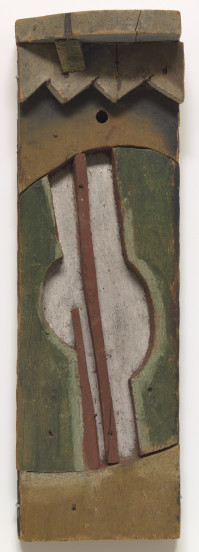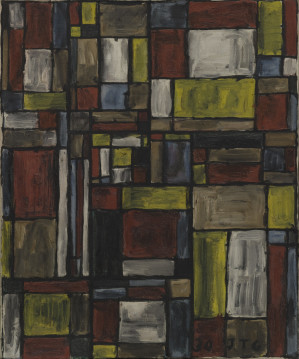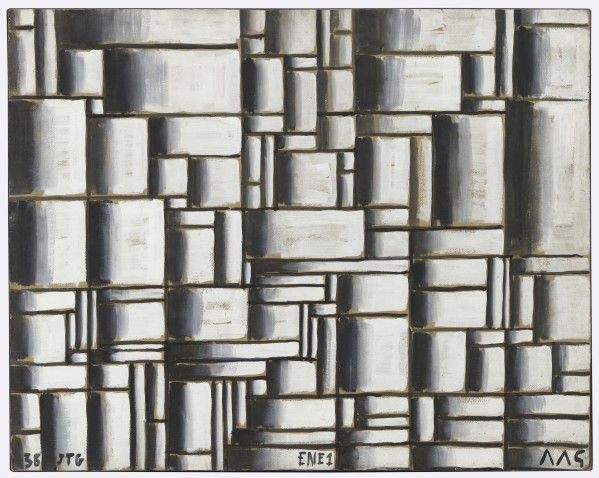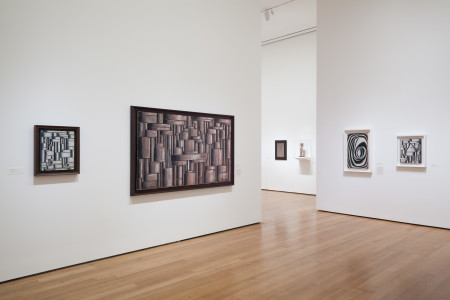REVIEW: Torres-García retrospective tracks Uruguayan artist’s output
![Joaquín Torres-García (Uruguayan. 1874–1949). Entoldado (La Feria) (Canopy [The fair]). 1917. Oil on canvas, 20 1/16 x 28 9/16″ (51 x 72.5 cm). Private collection. © Sucesión Joaquín Torres-García, Montevideo 2015](https://www.hollywoodsoapbox.com/wp-content/uploads/2016/03/torresgarcia31-e1457307955345.jpg)
An early charcoal drawing set the mood for the entire exhibition. “Dama de negro” depicts a woman with flowing, all-encompassing black clothing; her head peeks out from an oversized hat. The piece is a profile in eerie coldness, funereal and requisitely dark. Another “Dama” piece is a little more uplifting but similarly distant. This one has the woman standing in her black costume, looking down as if to pose. These early pieces, dating from the turn of the 20th century, are not exactly indicative of Torres-García’s eventual style. They simply provide a framework, an understanding of his earlier days.
In the 1910s, the artist produced some transfixing designs for frescoes. Using gouache on paper, he symbolized several religious and mythological themes, and MoMA even placed a sketch nearby to see a work in progress.

“Entoldado (La Feria)” marks a shift for the painter. The 1917 piece depicts a busy city scene with a wagon and awning in the background while passersby are drawn in a diagonal in the foreground. It’s an oft-putting painting because the hubbub of the city is depicted in harsh, vertical lines. A similar technique can be found in “Escena de una calle de Barcelona” and “Figura con paisaje de ciudad.” From the same time period, but more realistic and simpler in form, is “Bodegón con máscaras,” a still life that depicts several masks placed haphazardly on a table or desk.
In 1918, Torres-García bends toward the abstract with “Composición vibracionista,” a brilliantly dizzying array of movement and objects. A spectacled man takes the spotlight in the bottom third of the oil on canvas.
Clocks feature in “Composición vibracionista” and are a common presence in much of the Uruguayan artist’s work. One of the most prominent timepieces is the drawing for the book cover of “El descubrimiento de sí mismo.” The clock, with almost equal-length minute and hour hands, is topped by blocked letters that spell out the title and artist’s name.
An even larger shift in his emphasis occurs in 1918 with “Paisaje urbano, Barcelona,” which almost looks to be a city cut into vertical and horizontal lines, like a grid or series of boxes. The same structure can be found in “Ritmo de ciudad.”
He harkens back to his earlier paintings in 1920 with such creations as “Fourteenth Street (Business Town)” and “Street Scene, New York.” Torres-García seems enamored with the frenetic energy of metropolitan areas, and since some of these early 20th century paintings offer portraits of city life at the time of great industrial development in Europe and the United States, the people and the buildings seem to move in time with each other.
The artist’s New York years are also responsible for his fascination with children’s toys, which apparently were a means for him to make some money. MoMA exhibited these patterns of animals and humans cut into pieces, probably awaiting a young person to return them to balance. Some collages also emerge in this 1920s time period.

The style that Torres-García is most associated with — a series of vertical and horizontal lines intersecting at numerous angles — comes into fruition in the mid-1920s. Early basic examples include a “Guitar” from 1924, “Formas sobre fondo blanco” from 1924 and “Ritmos oblicuos con objetos fragmentados” from 1925. Some of these feature painted wood, others oil on cardboard. In these early years, one can sense that Torres-García is experimenting and circling the artistic idea that would transfix him for the rest of his life.
The wood pieces continue with “Repisa con taza” from 1928 and “Formas superpuestas” from 1931. However, it’s 1929’s “Pintura constructiva” that finds the artist take a firm step into the future. The industrial scene, colored with large white, red and baby blue blocks, offers simultaneous levels on the solitary sketch of a factory. That idea continues with a similar piece, featuring the same title, also from 1929.
From there on out, it’s scattered lines and color boxes for the foreseeable future. By 1930, his pieces are growing in size and complexity, featuring so many colors that the gargantuan works appear like studies of stained-glass windows. At first, these pieces appear simplistic, almost easily passable without a second thought. However, the connection of angles and lines have a deepening effect, allowing shapes and buildings to form in one’s mind after closer inspection. He also plays wonders with shading and three-dimensionality.

“Construcción universal” from 1931 is one of the best examples. A house, wine bottle and fish are boxed into a large pattern, almost as if the viewer is looking at a series of cubicles. “Constructif a double ligne” continues this idea, but it’s 1931’s “Construcción en blanco” that is the most startling for its sheer size and grand scope. The piece is surely a highlight of The Arcadian Modern, which now travels to Spain. Add to the highlight list “Estructura” from 1931, “Constructivismo” from 1931 and “Constructif à l’ancre centrale” from 1932, all quite exquisite and enormous in size.
The color is heightened and brightened in “Estructura con formas trabadas” from 1933 and “Locomotora con casa constructiva” from 1934. Several of these techniques and colors continue until the late 1940s and Torres-García’s last piece, “Figuras con palomas.”
Torres-García was a painter who strove to find his style, his niche, and after finding it, he decided to abandon its conformity and evolve his possibilities.
The Arcadian Modern, which was displayed chronologically and grouped around the artist’s time in Barcelona, New York, Paris and Montevideo, Uruguay, will now travel to Espacio Fundación Telefónica in Madrid from May 19 to Sept. 11 and Museo Picasso Málaga from Oct. 10 to Feb. 5, 2017. An accomplishing exhibition book is also available.
By John Soltes / Publisher / John@HollywoodSoapbox.com
- Click here for more information on Joaquín Torres-García: The Arcadian Modern.

